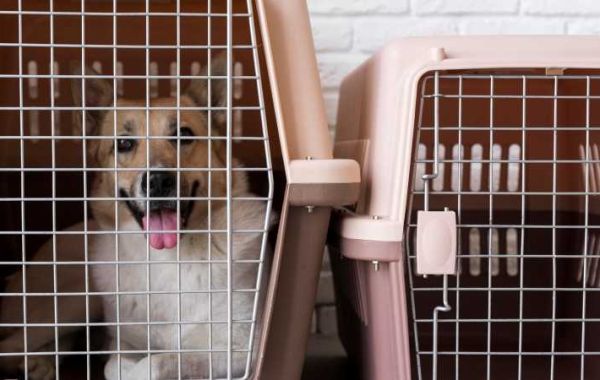If you're looking into buying or adopting a pet, there are a few things that you need to learn. Caring for a pet is not as easy as it seems. There are rules that you should follow to ensure that they are growing up in a beneficial environment, that they are trained and that they are well-behaved.
Training your dog is an essential aspect of being a pet owner. In order for you and your dog to both have a peaceful life, your dog needs to be trained to use its potty, not to scratch your furniture, and not to howl and be loud when left alone.
To make training more accessible, a lot of experts in pet care recommend the usage of dog crates. This type of crate for dogs can be used for many different reasons. They are very beneficial if you are teaching your dog to use the potty or if your dog is recovering from surgery. It is also recommended that you use a dog crate if you plan to travel with your dog in the future.
By having your dog adjust to staying in a crate from an early age, travelling with your dog becomes an easy task. The best thing about crates for dogs is that they come in many shapes and sizes and even colours, so there is always one suitable for you, but you should know a few tips on how to choose a dog crate in Australia.
How To Choose a Crate for Dogs?
When choosing the perfect crate for dogs, you should take into consideration the size of your dog. It is best that you try to help your dog adjust to using a crate from an early age when it is still tiny. Also, in terms of size, you should get a crate big enough for your dog to grow into so you avoid making the same investment into a dog crate in Australia when your dog inevitably starts to grow out of it. Another tip for the usage of dog crates is never to use a big crate with a small puppy when travelling. This way, you avoid unhappy accidents.
Another aspect to keep in mind when choosing a dog crate is the material it is made out of. Crates can be constructed out of various materials, such as wood, plastic or metal. Plastic crates are a popular choice since they are lightweight and easy to carry around, but metal crates are also a very prevalent choice, even though they come at a slightly higher price.
When buying a crate, you should consider what your dog's personality is, whether it feels more secure in smaller spaces or quite the opposite. If your dog is shy and likes to spend a lot of time by himself, then a smaller crate is the best choice. But a sizeable crate is better if your dog is more outgoing.
It is also essential to keep in mind the purpose of using a crate. If you are looking into buying a crate to use mainly for travelling, then a smaller, more compact one would do the job well. If the crate you want to purchase will only be used at home, then choose a more extensive, more spacious one.
What Are the Different Types of Crates for Dogs?
Whatever needs your dog has that require you to buy a crate, you can rest assured that a suitable one will undoubtedly be found. There is a wide variety of crates for dogs from which you can choose. And each of them is tailored to serve a specific set of needs certain animals have.
The first type of crate is the collapsible crate; it is one of the best choices if you travel a lot and take your dog with you or if you have limited space in your home.
Easy to fold when not in use and strong due to the metallic material they are made from, collapsible crates are just what you need if you want an easily storageable crate that does not clutter your home too much.
If your dog is shy or scared and is not used to being in a crate, then a soft-sided crate is the best choice for you. This type of crate is designed to look more like a den, and it can make your dog feel comfortable and secure. They are also very lightweight and easy to take with you if you want to travel.
The most common types of crates are the plastic and metal crates. Plastic ones are made out of high-impact plastic; they are lightweight, easy to move around and come at an accessible price.
While they are more expensive, metal crates have proven time and time again that they are the most durable. Since they are made out of steel or aluminium, they will undoubtedly stand the test of time.
Wood crates are perhaps the most unpopular type. While they are the best in terms of looks and design, they are pretty dangerous since dogs may find them fun to chew on.
Why Is Crate Training So Widely Recommended?
Crate training a dog is one of the best things you, as an owner, can do for it. A dog's instinct is to seek a space where it feels safe and can live a quiet and peaceful life. So, a crate can become just that for your dog. And it is especially needed when your house gets too loud and overwhelming. It prevents your dogs from having nervous reactions and from chewing on your furniture.
Crate training your dog comes in handy in your everyday life as well as in more unique situations. A dog's crate becomes its personal space, a little room of their own where they feel most comfortable. So, in case of scary situations such as exploding fireworks, thunderstorms or constructions, your dog can retreat to its crate and feel safer.
Crates are also perfect if your dog undergoes surgery. Following an invasive intervention, rest is required for dogs because it promotes a full, successful recovery. So, locking your dog in its crate ensures that it will rest well. That is if your dog has already been acquainted with its crate.
Being locked in a crate can cause stress to your dog if they are not used to it, so they can move around a lot, searching for an escape, and unintentionally cause themselves more damage post-operative.
What Not to Do When Crate Training Your Dog?
To avoid your dog associating the crate with negative emotions, you should keep in mind never to use it as a form of punishment. For instance, if you have guests over, it is best that you train your dog to be locked in so that when this situation arises, you know they are locked in securely, and so you avoid accidents from happening.
Locking your dog in its crate after it has misbehaved can make it associate the crate with fear and negative emotions.
You should also avoid leaving a puppy under six months in a crate for a long time. At that age, they cannot control their bowels or bladders well, so they will end up doing their business inside the crate.
Locking your dog in a crate for too long is also a no-go. Being locked up for such a long time can cause your dog to feel depressed. Dogs are sociable creatures, so social interactions are a big part of their lives, and they are a need.
If you want to learn more about what to avoid when training your dog to use a crate, you can read this article.
Teaching your dog to use a crate from an early age is the best thing you can do as a pet owner. But make sure to educate yourself on how to train a dog to use a crate properly. Crates for dogs come in many sizes and shapes and can be constructed out of various materials. You can find many types, and depending on your dog's personality and size, you can choose the best one for it.








